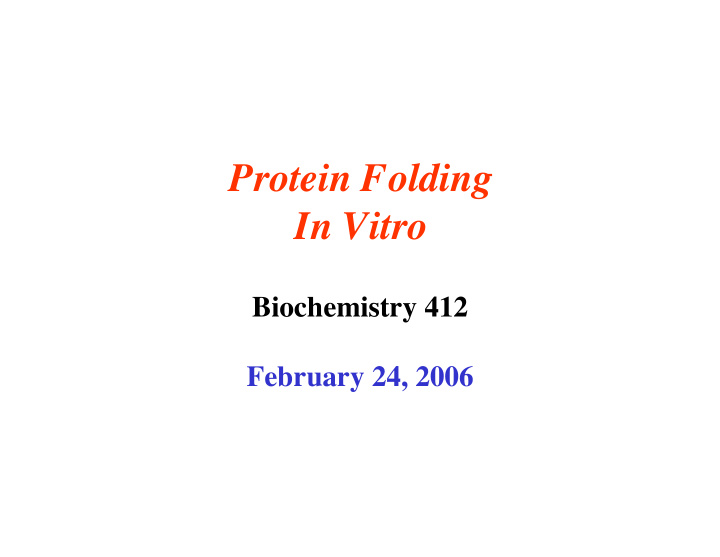



Protein Folding In Vitro Biochemistry 412 February 24, 2006
Fersht & Daggett (2002) Cell 108 , 573.
Some folding-related facts about proteins: • Many small, single domain proteins exhibit simple two-state folding behavior • Most proteins are only marginally stable (5 - 15 kcal/mol) under physiological conditions • Small proteins generally fold very rapidly, often in less than a second • During folding, proteins sample only very few of the total number of possible conformations (see Levinthal’s Paradox, below) And... • It is assumed that a protein’s amino acid sequence uniquely determines its native 3D structure
Outlined in red are the folding steps we will be covering in the in vitro part of the folding lectures. Dobson (2003) Nature 426 , 884.
Two-State Behavior Energetic and Kinetic Formalisms Let U signify the unfolded state and N signify the native state: K eq U N At equilibrium k fold [U] = k unfold [N] So K eq = [N]/[U] = k fold /k unfold And likewise, the stabilization free energy can be expressed as Δ G° = G N ° - G U ° = -RTlnK eq
Experimental (equilibrium) unfolding of proteins Creighton Proteins W. H. Freeman 1984, p. 288
Note that K eq is a function of the denaturant concentration, since denaturants by definition shift the equilibrium toward the unfolded state. In fact, lnK eq can be approximated as a linear function of the denaturant concentration, i. e., H2O - c [denaturant] lnK eq = lnK eq Where c is a constant for a given protein and set of conditions. The reason this is important is that linear plots enable you to accurately measure stabilization free energy differences between two different proteins (e. g., between a wild type protein and its mutant).
The Protein Folding Problem: Levinthal’s Paradox • Ribonuclease (124 residues) can potentially form about 10 50 conformations. If it tries a different conformation every 10 -13 seconds, it would take 10 50 /10 13 = 10 37 seconds or ~10 30 years to try all conformations, yet ribonuclease folds in ~1 minute. • There must be pathways of folding with sequential, dependent steps (intermediates), instead of a random “sampling” of all possible conformations.
Dobson (2003) Nature 426 , 884.
Generalized Free Energy Diagrams [for folding, let N (native state) = “B” = “P” and U (unfolded state) = “A” = “S”] K = e – ∆ G º/ RT For A ⇔ A ‡ [A] ‡ /[A] o = e – ∆ G º‡/ RT [A] ‡ = [A] o e – ∆ G º‡/ RT K = equilibrium constant ‡ = transition state [A] ‡ = concentration of molecules having the activation energy [A] o = total concentration – ∆ G º ‡ = standard free energy change of activation (activation energy)
Note that the transition state (TS) energy, G ‡ , can be indirectly measured based on its difference with the unfolded and native state free energies. Thus, Δ G TS-U = G ‡ - G U ° and Δ G N-TS = G N ° - G ‡ And Δ G TS-U = -RTlnk fold and Δ G N-TS = RTlnk unfold
Now…. Protein engineering rears its head!
Denaturation Data for Barnase Mutants Matouschek et al (1989) Nature 340 , 122.
Matouschek et al (1989) Nature 340 , 122.
Fersht & Daggett (2002) Cell 108 , 573.
Φ -Value Analysis
Baker (2000) Nature 405 , 39.
Vendruscolo & Paci (2003) Curr. Opin. Struct. Biol. 13 , 82.
Vendruscolo et al (2001) Nature 409 , 641.
Vendruscolo et al (2001) Nature 409 , 641.
Computational Protein Folding How are the theorists doing lately?
Baker (2000) Nature 405 , 39.
Recommend
More recommend